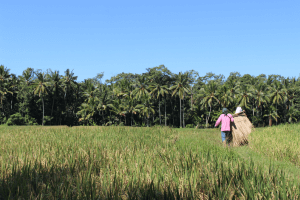At least 25 major aid organizations have been actively engaged in efforts to reduce Indonesia’s greenhouse gas emissions from land use over the last five years. Several of these funders, including the UK Climate Change Unit Indonesia, and the Norwegian Agency for Development Cooperation, have even refocused a large portion of their programs in Indonesia on the land use challenge.
This sharp focus isn’t surprising when you take into account that 44% of global land use and forestry emissions came from Indonesia in 2012 Last year saw unprecedented emissions from forest and peat fires in Indonesia, with emissions from fires alone expected to reach around 1750 MtCO2-eq., which is almost equal to Indonesia’s entire greenhouse gas emissions from all sectors in 2012.
The involvement of many international development organizations is also good news given that the Government of Indonesia has sent strong signals to the international community that their support is needed. Indonesia has committed to reduce greenhouse gas emissions by 26% by 2020, scaling up to 29% by 2030, and further extending their ambition to 41% with international support. Around 90% of that target is anticipated to come from reducing deforestation and peat emissions.
The question is, have the efforts been working?
We recently took on this question in a study that looked at international public climate finance flows to land use from major development partners, “Taking Stock of International Contributions to Low Carbon, Climate Resilient Land Use in Indonesia.”
We found mixed results.
Progress, but challenges
On the other hand, emissions from land use have continued to increase and numerous challenges block progress of government agencies, companies, and development partners who are attempting to maintain Indonesia’s rich ecosystems while promoting steady economic growth and breaking the cycle of rural poverty for 50% of the population that live near or under the national poverty line.
While OECD data tracks USD 2.3 billion of climate finance committed by international development partners to Indonesia over the four-year period from 2010 to 2013, just USD 176 million went to agriculture and forestry– a figure that seems off balance considering the importance and potential of the land sector in Indonesia.
The relatively low spend is partly explained by higher volumes of loan finance for other sectors, such as energy, while land-use finance is mainly delivered in grant form. Further, persisting weaknesses in the enabling environment for land use investment are another contributing factor. Instead of investments that directly decrease land use emissions, international development partners have focused on lower value, grant-based capacity building activities, which, while essential, have minimized the total value of international public finance. Numerous cooperation challenges have also hindered progress.
The way forward
So what’s next? While it’s clear that more money is needed in the medium term – meeting Indonesia’s targets requires an estimated USD 11-15 billion per year by 2020 – it’s also clear that several cooperation challenges have to be addressed in the near term that can both help existing finance flows to be directed more effectively, but also help finance scale up.
We make three recommendations for helping to unlock more fruitful cooperation and scale up finance to meet Indonesia’s land use goals:
First, development partners and the Government of Indonesia need to coordinate more systematically to support regulatory reform and improve systems. This coordination must include working together to form a vision for land use that is cross-ministerial, cross-jurisdictional, and cross-donor, and away from current silos. We recommend the creation of a comprehensive public database of international development partner activities and disbursements to enhance coordination and cooperation, and therefore effectiveness.
Second, development partners can make adjustments to improve effectiveness and longevity of funded programs. Our analysis shows that it would be more ideal if development partners provided stable funding for land use projects over extended durations. Longer periods of support can enhance impact by providing sufficient time to build partner capacity, implement activities on the ground, and deliver desired results. To achieve this, partners would need to delink their funding from shorter-duration political cycles and involve Indonesian local organizations in delivery of development programs. This would also enhance sustainability of outcomes, improving knowledge management and fostering stronger relationships with government partners via local experts.
Lastly, development partners can build up the capacity of Indonesian organizations and explore innovative public private funding partnerships in order to leverage greater finance and impact. This could include assisting Indonesian institutions to meet accreditation requirements to access international funds directly, forging public private partnerships involving state-owned enterprises and reputable foundations or local organizations, and streamlining development partner administrative requirements.
While these are not entirely new recommendations in the development debate, they warrant being restated, and a closer look, in the context of tackling Indonesia’s land use challenges.
Read the full study here: https://climatepolicyinitiative.org/publication/taking-stock-of-international-contributions-to-low-carbon-climate-resilient-land-use-in-indonesia/


